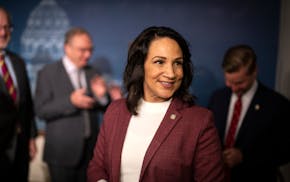Inflation is cooling after a hot start to 2024, but it's still higher than policymakers would like, leading Federal Reserve officials to pledge Wednesday to hold off longer on easing interest rates.
One culprit: The cost of auto insurance.
Consumer Price Index data released early in the day showed U.S. inflation rose 3.3% year-over-year in May compared to a 3.4% bump in April. Costs for some of the needs consumers feel most — food, gas, utilities — held flat or dropped month-over-month, but other necessities, including housing and medical care, were still on the rise.
Auto insurance is one of the hottest remaining issues, jumping a whopping 20.3% over last year.
After plummeting in 2020 as pandemic lockdowns kept drivers off the road — and insurance companies returned premiums to policyholders — the average cost of full car insurance has reached about $165 a month nationwide and $157 in Minnesota, according to personal finance website ValuePenguin. Industry experts point to a variety of reasons for the price increases, including rising repair costs for more complex cars, more frequent and serious crashes, severe weather and an uptick in consumer litigation.
"The reality is that auto insurers are in the business of providing financial security and a promise to their policyholders," said Tony Cotto, director of auto and underwriting policy for the National Association of Mutual Insurance Companies. "And as the cost of fulfilling that promise goes up, so must the cost of the actual product, of the insurance contract."
Auto repair and maintenance costs are 7.2% higher compared to May 2023, according to the Bureau of Labor Statistics, continuing a brisk climb that began in 2021. Other costs associated with driving, including the costs of cars themselves, have declined: Wednesday's federal inflation report showed a 9% year-over-year drop in the index for used cars and trucks.
Financing a vehicle purchase with a loan isn't going to get cheaper in the immediate future — Federal Reserve officials this week held the federal funds rate at 5.25%-5.5% — but easing inflation could prompt a cut later this year. Officials had earlier predicted three 2024 rate cuts but held off as inflation persisted, meaning borrowing costs will stay higher for longer.
"We are strongly committed to returning inflation to our 2% goal in support of a strong economy that benefits everyone," Fed Chair Jerome Powell said at a news conference Wednesday. "We are maintaining our restrictive stance of monetary policy in order to keep demand in line with supply and reduce inflationary pressures."
Some of what auto policyholders are seeing now is a correction from the height of the pandemic, when prices were unusually low, said Rick Gorvett, a professor in the department of mathematics and economics at Bryant University.
"There's a [cycle] to insurance, and we have periods where rates increase — not usually quite this much — but if you take the entire cycle, an up and a down portion of the cycle, you get a very reasonable kind of annual increase," he said.
Consumer advocates aren't convinced. Bilal Baydoun, director of policy and research at the Washington, D.C.-based Groundwork Collaborative, said he's skeptical that the external factors insurance companies are pointing to are enough to justify the degree to which they've raised prices. There's a power mismatch between these companies and consumers, he said, including the ability of insurers to lobby lawmakers and collect data on the behavior of individual drivers.
"I think the auto insurance sector is due for a reckoning, and I think eventually people are not going to be willing to tolerate this anymore," Baydoun said, noting consumer pressure has recently pushed other companies, including Target and McDonald's, to cut prices.
"They're going to want very, very clear explanations for why their rates are going up by the exorbitant levels that they are."
In the meantime, consumers can save money by shopping around with different companies, bundling home and auto insurance or — cautiously — dropping specific coverage areas such as rental car reimbursement, said Leslie Kasperowicz, managing editor at Insurance.com.
While the cost of auto insurance is unlikely to fall significantly — and the pressure on consumers will linger as policyholders renew at different times — industry watchers say they don't anticipate additional spikes.
"The insurance companies are starting to see things level off in terms of what their loss ratios look like, which is how much they pay out versus how much how much they make in premiums," Kasperowicz said. "So I think we're going to still see it climbing for a while, and then it will level off."

Want to share info with the Star Tribune? How to do it securely

'Safe recovery sites' would offer syringes, naloxone and more to people using drugs. The plan could be in peril.
New Minnesota GOP leaders seek peace with party's anti-establishment wing

Who is Republican Lisa Demuth, Minnesota's first House speaker of color?

